By Robert Bruce
“To instill the requisite antiterrorism warfare mindset – Navy wide – and to create the premier security force for the world’s greatest naval power…” Center for Security Forces Vision Statement.
SAR’s loyal readers will recall our first encounter with the US Navy’s Center for Security Forces (CSF) in our report on the US Coast Guard’s Special Missions Training Center (SAR September 2006). A large percentage of students in SMTC’s Small Boat Crew-Served Weapons Course were US Navy Sailors, undergoing extensive training in the martial art of effective machinegunning on land and at sea.

Makes sense, we thought, as these Bluejackets were from the Navy’s Mobile Security Squadrons. Basic Crew-Served Weapons training for these and other Sailors has been done under CSF, then known as the Center for Antiterrorism and Navy Security Forces, since its establishment in June of 2004.
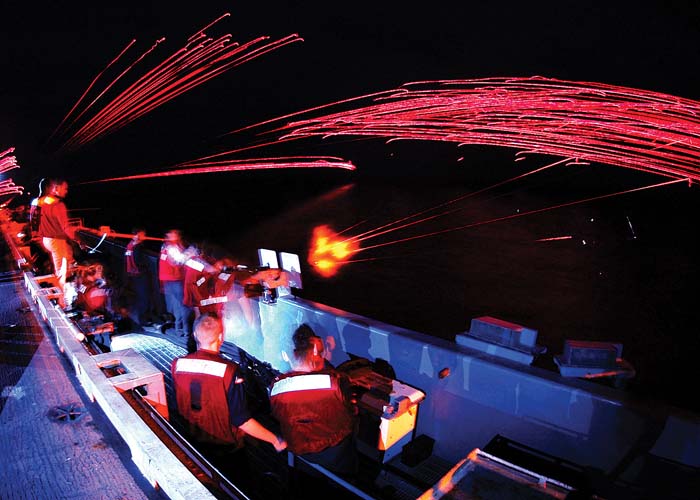
It wasn’t until January 2006, when the Navy Expeditionary Combat Command (NECC) was established, that CSF was faced with the additional challenge of preparing Sailors for the demands of expeditionary unit level training. How, we wanted to know, is CSF handling these vitally important missions?
A request for more information, launched through the Navy’s elaborate public affairs apparatus, was answered in surprisingly short order and we were invited to CSF for an orientation visit.
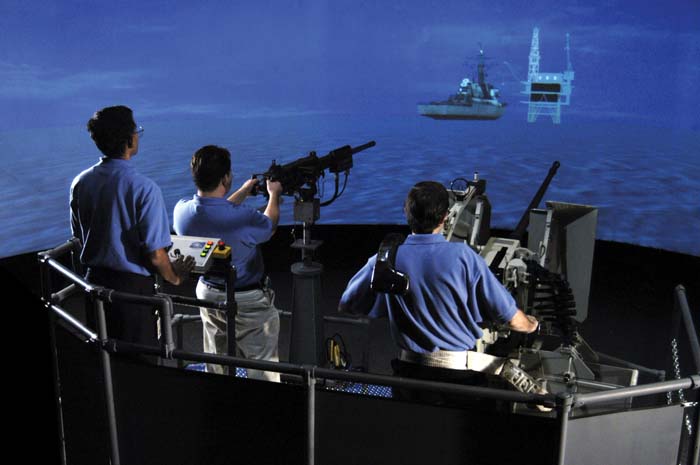
Headquartered aboard Naval Amphibious Base Little Creek, Norfolk, Virginia, CSF shares its home with numerous elite units, including Naval Special Warfare Groups Two and Four. NECC is also formidable presence on the 2,500 acre base, serving as a central hub for diverse components including SEABEES, EOD, Riverine Forces, Navy Individual Augmentees and others.
Our host for the morning was Lieutenant Brian Simpson, a seasoned thirty-four year old career officer whose primary duty assignment is Assistant Expeditionary Warfare Program Manager. He is also CSF’s collateral duty Antiterrorism Officer and collateral Public Affairs Officer, a combination that makes him, in our humble opinion, a particularly credible source.

First order of business was the Center for Security Forces Command Briefing, an essential overview of the mission, structure and capabilities of this little known but undeniably essential organization.
At first glance, CSF’s mission “To produce disciplined, motivated, physically fit and tactically proficient Sailors who embody Navy Core Values and who are fully prepared to augment combat security forces around the world,” may seem overly ambitious. However, when backed by the right people, such lofty goals can be transformed into a practical reality. Staffed by some 690 dedicated military, civilian, and contract personnel, CSF graduated more than 21,000 Sailors from seventeen training sites across the continental U.S., Hawaii, and Japan during the past year.
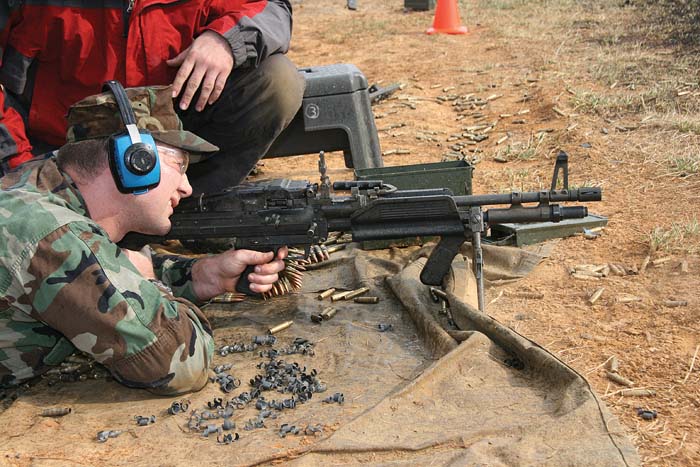
(Photo by Robert Bruce)
Additionally, thousands of other Sailors have gained invaluable professional knowledge from the Center’s offerings on NKO (Navy Knowledge Online) an internetbased resource for self-paced instruction.
Curriculum
CSF’s impressive course list contains more than 45 subjects grouped into four program areas: Antiterrorism (AT); Visit, Board, Search, and Seizure (VBSS); Code of Conduct (CoC); and Expeditionary Warfare (EW).
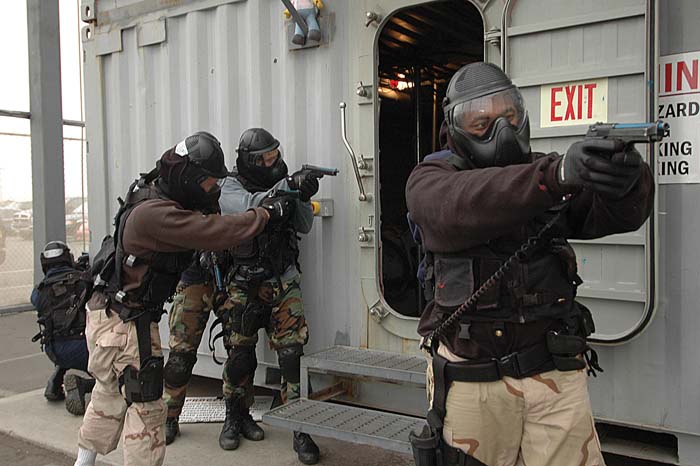
(US Navy photo by Photographers Mate Airman Derek Sanchez)
As the command’s official title suggests, security force related training comprises the majority of CSF’s offerings. Accordingly, the AT program is the largest, dominated by the security requirements of the Navy, and reflects the Navy’s reliance on CSF to conduct “A School” (initial Military Occupational Specialty qualification) for the Master- at-Arms (MA) rating, as well as antiterrorism instruction for Commanding Officers, selected staff officers, and security force personnel throughout the Navy.
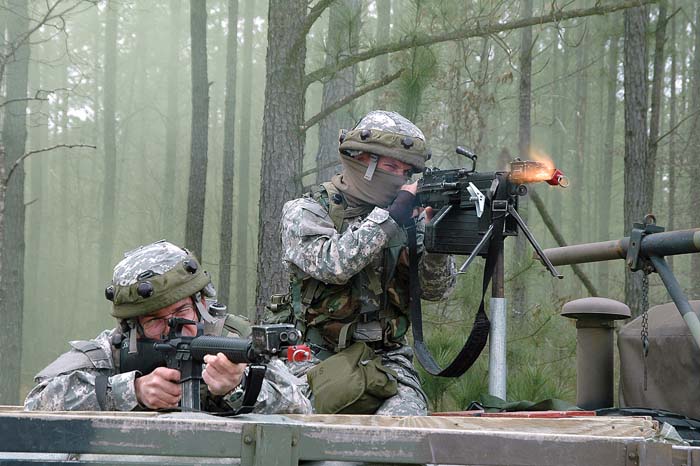
“The majority of our MA’s receive their initial training at Navy Technical Training Center, located onboard Lackland Air Force Base in Texas,” Simpson explained, “but back in March 2006, CSF had to establish a second MA ‘A’ School here in Norfolk to meet the increased demand for MA support in the Navy’s various missions in the Global War on Terror.”
Instruction for Sailors in many specialties tagged with specific Navy Enlisted Classification (NEC) codes is also provided by CSF. Courses include Correctional Specialist Ashore/Afloat, Military Working Dog Handler/Kennel Master, Military Police Investigator, Protective Services, Non- Lethal Weapons Instructor, Small Arms Marksmanship Instructor, and Crew Served Weapons Instructor.
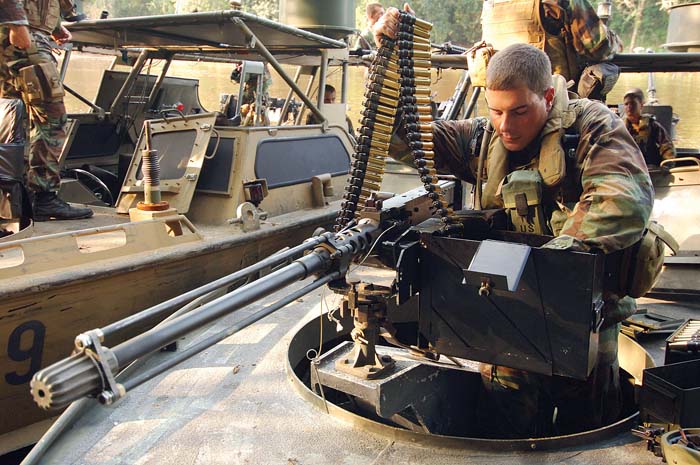
Certain AT courses, such as Security Reaction Force-Basic (SRFB), provide the foundation for CSF’s VBSS program and include essential training for personnel assigned to Advanced SRF and Non-Compliant Boarding (NCB) VBSS teams. Sailors assigned to these critical mission areas learn advanced shooting techniques and the other skills necessary to conduct pier side security and “blue water” Maritime Interdiction Operations (MIO).
The Navy’s need for NCB VBSS training is a direct result if increasing numbers of compliant inspections and their potential to turn ugly. This prepares search teams to deal with hostilities that may arise if violations are detected.
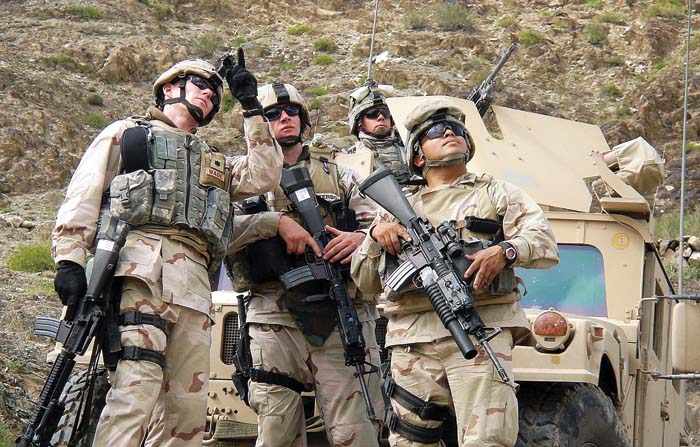
Code of Conduct (CoC) training applies to all Navy personnel. Introductory instruction is provided to those who have just joined the Navy, followed by periodic refreshers. Additional training is provided to those personnel deploying to various theaters of operations, including Iraq and Afghanistan.
Advanced Code of Conduct training, or SERE, which stands for “Survive, Evade, Resist, and Escape,” is provided to those persons categorized as being high risk of capture (HRC), particularly aircrewmen and Special Warfare personnel . While the introductory, basic, and intermediate level Code of Conduct courses can be taught nearly anywhere, SERE training is limited to two specialized CSF learning sites, located on either coast.
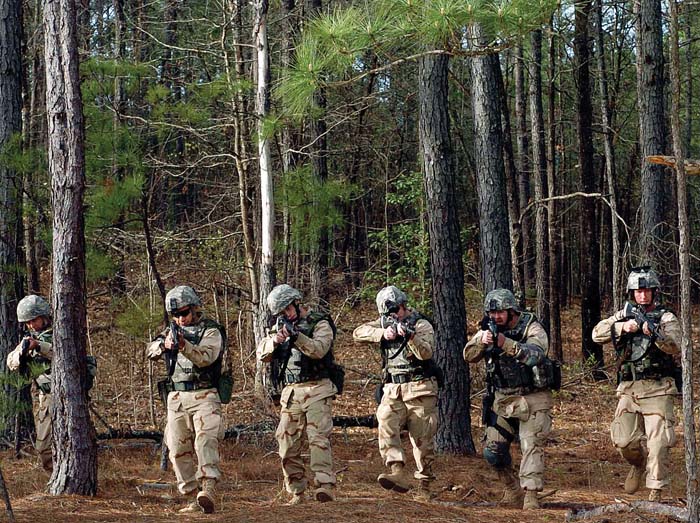
(US Navy photo by Journalist 1st Class Jackey Bratt)
The unyielding demands of Expeditionary Warfare drive the last grouping, and CSF has risen to the challenge with six intense courses specifically tailored for individuals reporting to units deploying to Iraq, Afghanistan, and various other locations around the world.
Simpson emphasized how the Center’s Expeditionary Warfare program is aligned with several strategic objectives as set forth by the Navy Expeditionary Combat Enterprise (NECE). This is a cooperative effort between NECC and its constituents on the Navy’s operational side, and various commands on the training side including CSF.
“When NECC was established, some of its training requirements drew heavily on courses already established by CSF,” Simpson said. “Others, such as the CSWI course, weren’t a perfect fit and have been revised accordingly.”
Brown Water Navy
CSF has also created new courses to support training for some of NECC’s newly established components, particularly the riverine force. Manning the brand new Riverine Squadrons (RIVRONs) necessitated an urgent requirement to write and implement training packages for Boat Captains, Tactical Coxswains, and plenty of gunners like the ones SAR had encountered at SMTC.
“CSF, with direction from NECC and assistance from the Marine Corps, has diligently worked to define and reestablish the Navy’s capability in this arena,” Simpson said.
Also notable are the Small Craft Maritime Interdiction Operations course. Although similar to the NCB-VBSS course in concept and objectives, Small Craft MIO presents more of a challenge because of the environment.
Rather than boarding and searching large merchant vessels at sea where third party threats are more easily detected, Sailors are now securing and searching smaller boats on inland waterways where a third party threat has the potential to appear from any direction. This 360-degree threat environment presents unique challenges not often encountered by typical blue-water Sailors.
Simpson underscored the importance of CSF’s standardization and quality assurance programs. “One of our primary objectives is to ensure the training we deliver is both consistent and on target with the needs of the Navy.”
Consistency implies that all Sailors who have received CSF training on a particular subject have the same skills and knowledge, regardless of where they were trained. “We continually strive to ensure our courses meet operational requirements, are effective, and fit within current budgetary constraints.”
This is obviously a delicate balancing act when money is tight, requirements shift, and effectiveness is measured in the metaphor “how well you can hit a constantly moving target.”
Combat Skills Training
While the Navy’s Expeditionary Warfare mission requirement is growing and requires more Sailors to operate in potentially hostile surroundings, combat skills training is not part of the typical Navy Fleet experience. Although similar in content, the training for those Navy commands already operating in the expeditionary arena has been developed independently and to varying degrees of proficiency depending on mission requirements.
CSF is working to develop and establish a basic combat skills course for the Navy Expeditionary Combat Command. This course, dubbed “Expeditionary Combat Skills” or ECS, features several elements working together, providing standardized individual basic combat skills training to all NECC personnel.
The curriculum for this 4-week course includes combat shooting with the M9 and M4, land navigation, radio procedures, and combat casualty care using the time-honored “crawl, walk, run” progression. Classroom, field, and realistic, scenariobased training will force students to get their hands dirty and think on their feet while they learn to “shoot, move, communicate, and care.”
NECC’s desire is to eventually expand ECS content to 8 weeks and include training for chemical/biological warfare defense, crew-served weapons, and convoy operations.
The Center for Security Forces also plays a key role in the combat skills training of Navy Individual Augmentees (IAs). “This particular group of Sailors faces a unique challenge,” Simpson observed, “because they are reassigned from a familiar Navy environment to perform similar duties with other services, typically the Army.”
This unusual situation has become necessary due to the intense operational tempo of GWOT, leading to additional requirements in specialized fields such as EOD and Electronic Warfare.
The Navy has gone to great lengths to smooth this transformation with dedicated orientation training. For example, Navy Electronic Warfare (EW) specialists deploying to an Army unit will learn not only how the equipment and tactical employment differs, but also the many cultural differences like jargon (e.g., latrine vs. head), Army customs and rank structure.
“Sailors receive ‘differences training’ between Navy and Army methodology and philosophy while learning the basics of land warfare and combat tactics in order to prepare them for a potentially hazardous environment,” Simpson explained.“We want to minimize the potential danger Sailors pose to themselves and friendlies or neutrals while maximizing the danger they pose to the enemy.”
This last part plus a whole lot more is packaged in a concentrated 12-day course called Navy Individual Augmentee Combat Training (NIACT). CSF’s NIACT curriculum is delivered in a very unusual partnership with the Army at Fort Jackson, South Carolina where Navy personnel bound for Army assignments undergo a crash program of instruction delivered by Army Reserve Drill Sergeants.
Clad in desert camouflage battledress with helmets, body armor, canteens and other gear, Sailor-Soldiers get full immersion combat training built on an intimate relationship with the iconic M16A2 rifle or the handy little M9 pistol. This bond is forged over several days of concentrated instruction on safe handling, maintenance, operation, marksmanship, and qualification.
Additional weapons training follows with familiarization firing of all the Army’s standard infantry machine guns including the 5.56mm M249, 7.62mm M240, .50 cal. M2HB, and 40mm MK 19. Battlefield survival training continues with land navigation, individual movement techniques, radio communications, first aid, military operations in urban terrain (MOUT), IED recognition and avoidance, and convoy operations.
New Initiatives
We asked Simpson to tell us about any new developments at CSF. What is the latest challenge that needs to be met?
“Judgment-based Engagement Training, or JET,” he immediately replied. “The JET concept integrates combat shooting with the ability to ‘think on your feet’ while taking into account the overarching concepts of Rules of Engagement, Rules for Use of Force and Escalation of Force.”
The goal of JET training, as Simpson explained, “is to develop the cognitive and shooting skills a Sailor needs to be able to assess a rapidly evolving situation based on the information at hand, decide on a course of action, take the action decided upon, and evaluate the result.” CSF’s desire is to train Sailors not only how to shoot, but just as importantly, when to shoot in a combat situation.
Find out More
The Center for Security Forces provides training and human performance solutions to Navy Expeditionary, Security, and Antiterrorism professionals to meet the needs of the Fleet. The Center trains Navy personnel worldwide in security and antiterrorism measures and procedures. CSF’s focus tends toward supporting personnel serving in the Master-at-Arms (MA) Rating, Sailors assigned in an antiterrorism role, Navy Security Officer communities, and the Navy Expeditionary Combat Command (NECC). CSF reports to the Naval Personnel Development Command (NPDC), and falls under the Naval Education and Training Command (NETC) claimancy.
CSF website: www.npdc.navy.mil/csf
NECC website: www.necc.navy.mil
US Navy: www.navy.mil
Coming Soon
Our interest in CSF was further rewarded by Lieutenant Simpson’s invitation to observe a Crew-Served Weapons Instructor Course in progress. Come along as SAR journeys to the Headquarters of the US Marine Corps at Quantico, Virginia, for a fine day of live fire machine gun training.
| This article first appeared in Small Arms Review V11N5 (February 2008) |











